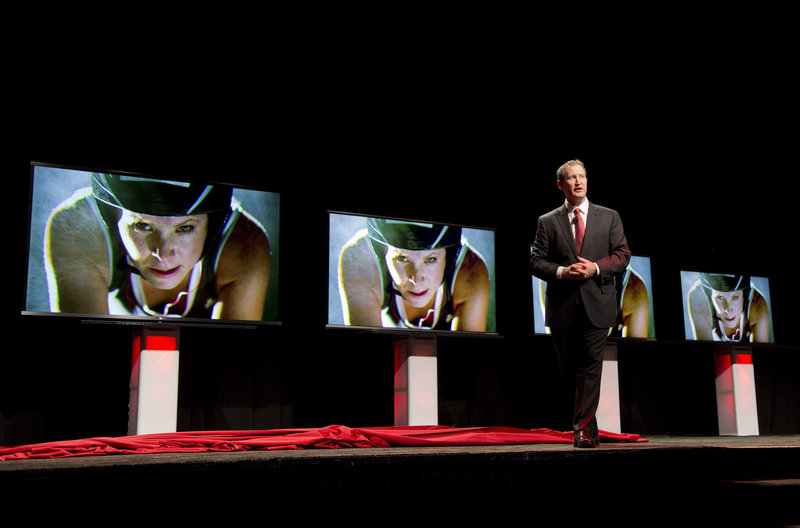LAS VEGAS – The race to make TVs larger and larger has created a colossal problem for manufacturers: As screens grow, picture quality worsens — unless the viewer moves farther away from the screen.
The issue is playing out in cozy dens and family rooms around the world. To get the full benefit of a large high-definition screen, viewers must move back from their sets. Because the ideal viewing distance is no closer than three times the height of your screen, or about one and a half times the diagonal length, big TVs have forced many families’ backs against the wall.
This year, TV makers are doing their best to give huge-screen fanatics more breathing room. New “ultrahigh-definition” sets were shown off Monday by companies such as LG Electronics Inc., Sharp Corp. and Samsung Electronics Co. at the International CES gadget show in Las Vegas.
TV makers are also making their sets smarter. New TVs from Samsung, for instance, will recognize an expanded range of gestures so people can swipe through on-screen menus in a way that revolutionizes the old remote control.
Samsung President Boo-Keun Yoon said the new features are a response to the increased choices consumers have in what they watch.
“We have developed TVs that respond to people’s needs and lifestyles, TVs that know in advance what people want to watch, TVs that have the power to create the ultimate lean-back experience,” Yoon said.
With nearly 8.3 million pixels, an ultrahigh definition screen contains four times more pixels than an HD TV. Because of the higher resolution, viewers can sit close — according to some estimates, as close as the diagonal length of the screen, which is about a third closer than before — without losing clarity. That could be appealing to big-screen fanatics who live in small spaces.
Ultra-HD sets come as small as LG’s latest model, which stretches 55 inches diagonally. And estimated prices are dropping from the tens of thousands to below $10,000, bringing these multi-megapixel TVs well within the spending range of early adopters.
It could be a few years before prices come down enough for the masses to justify buying ultra-HD TVs, especially considering that U.S. TV buyers spent a record-low average of $364 on flat-screen TVs during the recent holiday shopping season, according to research firm NPD Group.
Hampering sales even further, ultra-HD faces another problem: There’s very little content. Since 2004, only about 50 movies have been shot with an ultra-HD camera. They include the James Bond hit “Skyfall” and the Batman sequel, “The Dark Knight Rises.” Only a handful of movies shot on film, including “Taxi Driver,” have been converted to ultra-HD.
There’s also no standard way of getting content to the TV.
Sony Corp.’s 84-inch ultra-HD model, which it unveiled in November, comes with a computer server capable of storing and playing back giant movie files. It’s definitely not affordable for most people, however, and the TV unit with the server thrown in has a price tag of $25,000.
There’s also currently no standard way for upgrading Blu-ray players and discs to handle the ultra-HD format, although plans are in the works. Broadcasters are also a few years away from an upgrade.
LG said its ultra-HD set will have upscaling technology to make regular HD images look better — the way some motion is smoothed out on some TVs using computer algorithms.
Send questions/comments to the editors.



Success. Please wait for the page to reload. If the page does not reload within 5 seconds, please refresh the page.
Enter your email and password to access comments.
Hi, to comment on stories you must . This profile is in addition to your subscription and website login.
Already have a commenting profile? .
Invalid username/password.
Please check your email to confirm and complete your registration.
Only subscribers are eligible to post comments. Please subscribe or login first for digital access. Here’s why.
Use the form below to reset your password. When you've submitted your account email, we will send an email with a reset code.